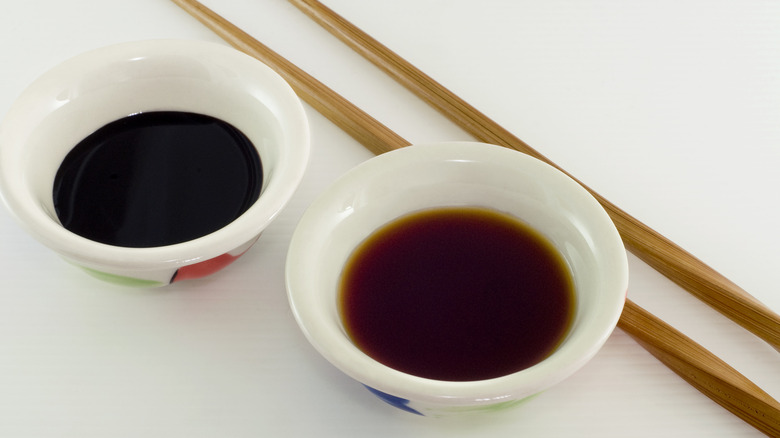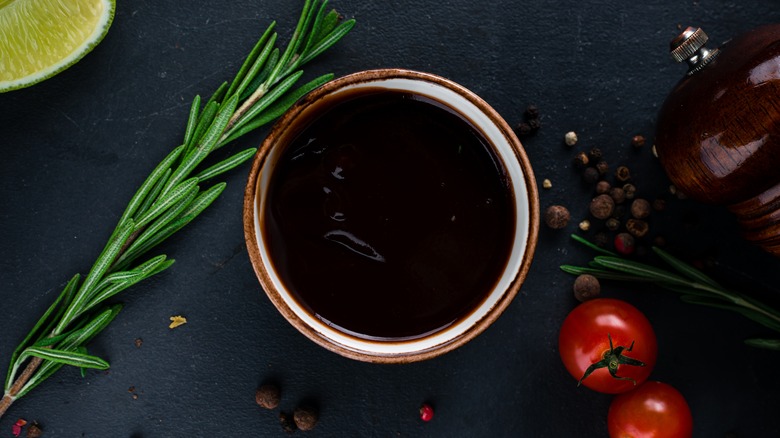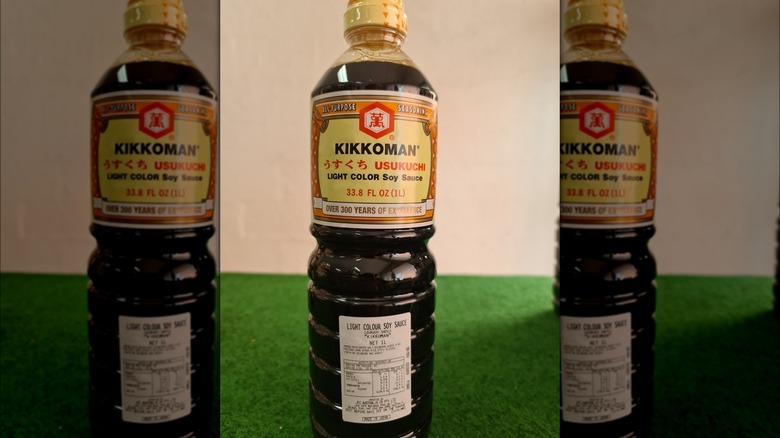The Flavor Difference To Know Between Dark And Light Shoyu
If you're a fan of sushi, dumplings, or ramen, there's a good chance you've had shoyu, Japan's style of soy sauce. Produced by fermenting salt, wheat, and soybeans with the help of koji (Japan's national yeast), shoyu has been brewed for centuries and is a cornerstone of Japanese cuisine.
Shoyu is commonly used as a dipping sauce, seasoning, or marinade and is prized for its umami specifically, but the condiment (like all varieties of soy sauce) is unique in that it also contains the other four taste elements — sweetness, bitterness, saltiness, and sourness. In addition to being a flavor powerhouse, soy sauce can also be used to tone down less-appealing aromas and can even be effective at killing off bacteria like E. coli.
Japan takes its shoyu seriously, specifically certifying the various types through Japan Agricultural Standards (JAS). Currently, there are five types: koikuchi, usukuchi, tamari, saishikomi, and shiro. The two most common are koikuchi (dark) and usukuchi (light), accounting for 80% and 10% of domestic production, respectively.
Both dark and light shoyu have the characteristic foundational flavors that you'd expect from a soy sauce, like rich umami flavor and the sauce's signature saltiness. However, there are some fundamental differences between the two that extend beyond the color of the sauce. Knowing the difference that can help you determine which to use with specific dishes.
What is koikuchi shoyu, and how do you use it?
By far the most ubiquitous shoyu, koikuchi is produced by many of the 1,200 shoyu breweries in Japan. The most recognizable brand may be Kikkoman, the best-selling brand around the globe, with its signature red-topped bottles (or green, for low-sodium).
Koikuchu is characterized by its dark reddish-brown color. In terms of umami, which is determined by measuring the amount of glutamic acid, koikuchu clocks in as containing the second highest amount out of the five JAS-classified shoyus, with tamari in the top spot. Koikuchu's saltiness is moderate compared to the other shoyus, at about 16-17% salt content. That's higher than saishikomi, but less than the two lighter shoyus.
Koikuchu's high level of umami and moderate saltiness make it one of the most versatile shoyus. It enhances the flavors of most meats and pairs well with plant-based meals. It's also ideal for dipping when it comes to dumplings, sushi, and sashimi. The only time koikuchu may not be the best pick is when you want to retain the light colors of ingredients like tofu or white rice.
What is usukuchi shoyu, and how do you use it?
Usukuchi shoyu is popular in the western region of Japan where it's believed to have originated in the mid-1600s. However, it's not consumed nearly as much throughout the rest of the country as compared to koikuchu.
Sometimes the word "light," when used in reference to soy sauce, can refer to the sodium content, but in the case of shoyus, the term is used to describe the color. Lighter than koikuchu, usukuchi is the second lightest shoyu, with a pale amber hue. In fact, usukuchi is significantly saltier than koikuchu, with a salt content of about 18-19%, the highest of all of the shoyus. And while usukuchi does have significant umami flavor, it is still, comparatively, at the low end of the scale at second to last, just above shiro.
Usukuchi's high salt content makes it a better contender for seasoning dishes while cooking rather than for dipping, and its relatively pale hue means it's perfect for use with lighter-colored foods. The salty sauce can be used in soups or stews and works particularly well with tofu, helping its nutty undertones shine. The only caveat that comes with usukuchi is to remember that a little bit goes a long way.



